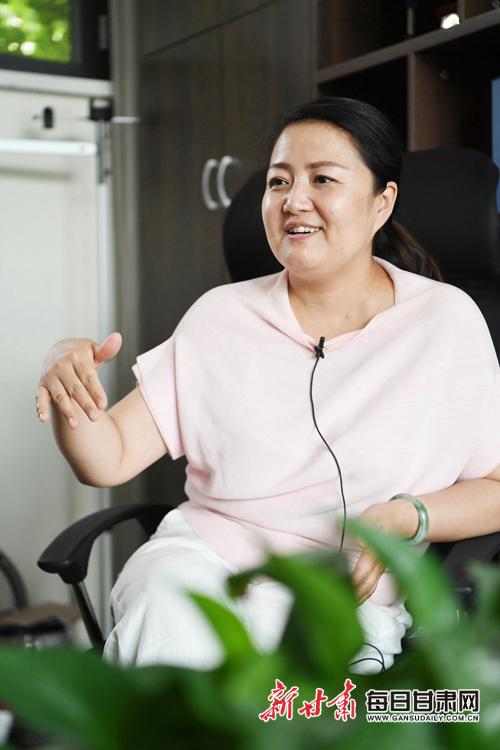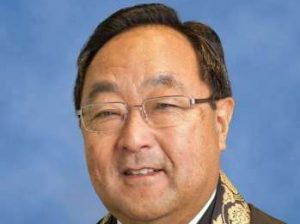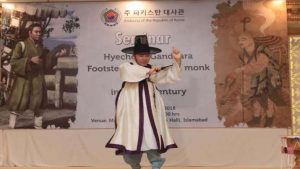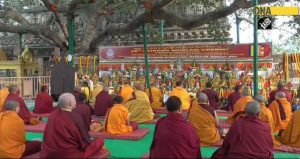Founded in 1944, the Dunhuang Research Academy’s (敦煌研究院) popular history is filled with male names. There is the reviled Wang Yuanlu (1849–1931) who discovered the Library Cave (Cave 17) and sold off many of the priceless scrolls to foreign explorers and scholars, said “plunderers” such as Aurel Stein (1862–1943) and Paul Pelliot (1878–1945), as well as the acclaimed founder of the Academy itself, painter Chang Shuhong (1904–94). My own experience of contemporary Dunhuang has been dominated by women of influence and authority in agenda-setting positions. My first trip to this heritage town in 2014 was as a tag-a-long with Hong Kong-based writer Mei-yin Lee. While she is not a formal scholar of Buddhist heritage or archaeology, she has long been respected as one of Hong Kong’s most erudite and engaging speakers on Mogao’s murals, art, and history.
Lee is known to be an old friend of the Dunhuang Research Academy. If one is serious about real access to Dunhuang’s heritage and network of modern guardians, it is impossible to bypass this institution. In fact, most of these said custodians come from the academy, having been trained or employed there. They protect the Dunhuang sites, no longer with swords or amulets, but with cutting-edge technology and government support.
The academy is the foremost institution tasked with preserving a slate of heritage sites in Gansu Province. The most prominent remains the Mogao Caves, where the main center of the academy is based. There are other locations along the Hexi Corridor under the academy’s purview, including Guazhou County’s Yulin Caves, the Western Thousand Buddha Caves, and the Xiangtangshan Caves. But the Mogao Caves are perhaps the most prestigious Buddhist sites in China to care for, because they were among the first locations in China to be listed as UNESCO World Heritage Sites in 1987, along with the Great Wall, the First Emperor’s mausoleum, and the Ming-Qing palaces of Beijing—some of which now constitute the Palace Museum.
Mogao is the specialty of several specific departments among the academy’s 12, which employ more than 1,500 staff members. The somewhat plainly named visitor reception department (文化弘扬部) is among the academy’s most influential. This is because the scope of “visitor reception” is much larger than it sounds: it means that the department sets guidelines on which caves tourists and researchers can visit, how docents at Mogao should train, and which sites they should be posted to before they advance in their careers, and the digitization of the Mogao Caves—which encompasses app development, websites, WeChat shows, and more.
One of the most important women at the Academy is Song Shuxia (宋淑霞), who I travelled to Dunhuang in April once more to speak to. Her position as the visitor reception department’s deputy director gives her considerable weight in matters pertaining to the protection of the Mogao Caves. Her name rarely appears in English-language publications, but she has had a hand in, or initiated, many digitally related projects over the years. These include exhibitions locally or throughout China—Mysterious Dunhuang in Shenzhen in 2018 was one such exhibition featuring digital technology. There are many other performances, exhibitions, and shows throughout Dunhuang and Greater China that have had the academy’s seal of approval.
Song is an heir to the conservation tradition that favors digitization as a way to preserve the caves and its material contents for as long as possible. This has resulted in “Digital Dunhuang,” a digital platform and technological blueprint rolled into one. It also encompasses the digital heritage center, which is immensely important to the academy’s strategy. Much of its development was overseen by Dr. Fan Jinshi, the academy’s third director, and continued with her successor, Wang Xudong, who was director until 2019. The current director is Zhao Shengliang, and Zhang Xiaogang is head of the academy’s archaeology institute.
At 84, Dr. Fan remains a legendary name in Dunhuang and Silk Road studies, being one of the extraordinary women who helped carry the early decades of Mogao research on her shoulders. Assigned to Dunhuang in the early 1960s, Dr. Fan lived as past generations of devotees and pilgrims would have done: in an abandoned temple. Her experience attests to how far Dunhuang has come since its early status as a desert outpost, which only started to change in the 2000s. Fan and others had little to work with in the early days of conservation—to protect the relics and treasures from sand and humidity, she and fellow workers put the first doors on the caves, planted the trees that now line the main complex, and began monitoring cave temperature and moistness.
The manifest need to control visitor numbers began gaining momentum in the early 2000s. “We began some preliminary attempts of digitization in the 1990s and we had already collected a large number of resources—photos, video recordings, and so on—on our computers. Prof. Zhang then proposed that we should build a digital display center as part of our future with digital technology, which would boost tourist management and heritage protection,” said Song.
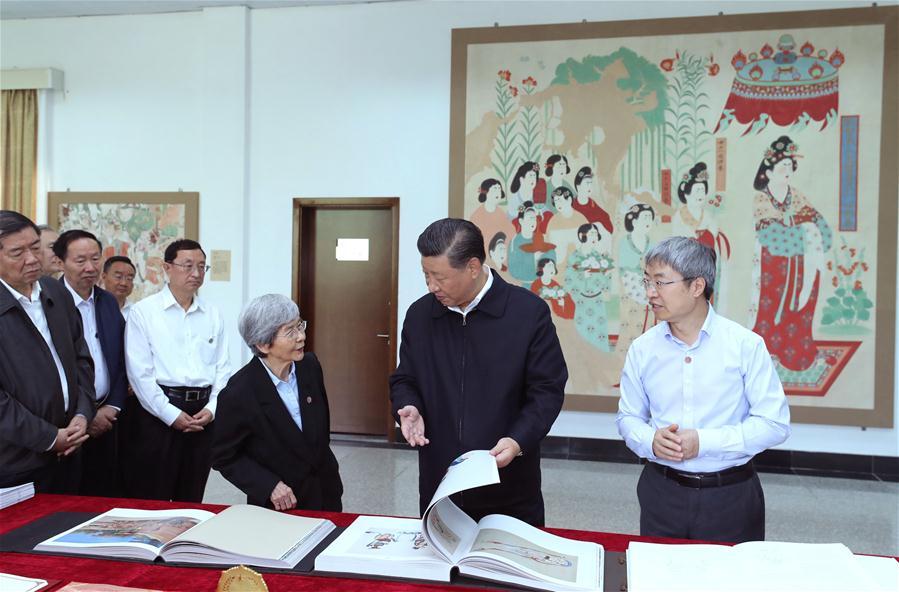
The conservation philosophy of the academy is one of keeping the caves and their art and interior murals and sculptures as they are, rather than restoration. “We started this digital cooperation with Northwestern University in the US between 2002 and 2003,” Song recalled. “This coincided with an explosion of tourism in China [it was during the early 2000s that China began to economically open up to the world significantly], which had a big impact on the caves.”
Things were moving ahead with the digital heritage center at this time, too. “In 2003, Dr. Fan Jinshi, a long-serving representative of the Chinese People’s Political Consultative Conference (CPPCC), put together a proposal with other members to build a digital display center. We consider all the Dunhuang grottoes, including the Mogao complex, to be immovable cultural relics,” said Song. “This is a disadvantage as far as the caves are concerned; as the years pass, the natural environment and human impact of tourists degrade the sites. Many murals in several caves reveal an ongoing process of degradation and decline despite our best efforts.”
One of the most consistent rules is that should a cave show signs of continuous deterioration, it will be closed forever, with a select few remaining open to private access approved by the academy. I was fortunate enough to see several caves at this “tier” while bypassing the caves that are open to the general public, but they can only be entered with an appointed docent. Mine was an eloquent and friendly fellow called Lu, who spoke perfect Sanskrit and English and was one of the more experienced docents at Mogao.
Lu and his colleagues adhere to an organizational policy of guiding crowds into public caves smoothly and quickly, spending no more than five minutes in them. These considerations can be traced to the same year as the academy’s collaborative beginnings with northwestern. Things had already taken on an acute urgency—between 2004 and 2014, a total of five million visitors had come to the Mogao Caves, and 2014 was a landmark year for another reason: the digital heritage center was finally completed.
The center is an architectural masterpiece, spacious and tasteful. I followed the “flow” of people there, first joining a line—only for residents of Hong Kong in mainland China—and buying a ticket for the digital heritage center’s facilities. The lines were tightly controled and curated, and I lined up for a while in a winding snake of people before being shown into a humongous theatre with a 3D screen.
Song is forthright about the intentions of the digital heritage center: “It is quite honestly equivalent to our ‘firewall.’ This firewall directs tourists a place where we can sort and group them to alleviate a crush of high numbers at the main site. Our fundamental purpose is to allow large bands of tourists to settle down here first, before they eventually see the actual place. All the while, we maintain a good atmosphere for everyone even as we regulate the pressure of the huge numbers.”
This reduces crowded queues and allows for a process of orderly regulation, which smooths out the flow of tourists through its theater, while also calming and organizing the more disorderly visitors and the overall crowds before shepherding them onto the buses to the grottoes. These attempts at efficiency seem less severe once one is there in person during peak season and sees extensively long lines and huge sizes of these crowds.
“So far, it has received more than a million tourists, and so far, the results have been very good. Even from our monitoring data, we can see that through this kind of regulation, we are alleviating the pressure on the ‘core protection area’ of Mogao’s cultural relics, which means that the pressure of cultural relics themselves are also alleviated.” She said that improvements were not simply wishful thinking but could be tracked, recorded, and compared: “We can objectively measure rates of temperature, humidity, and carbon dioxide concentration [emitted by people breathing] in the caves where we regulate visitor numbers.” The signs from the data monitoring inside the caves’ microenvironments indicate that these factors have been reduced.
Song is mindful of the history of the academy’s research into visitor trends, which combines heritage tourism, museology, and conservation concerns: “In 2002, we started a survey on the site’s carrying capacity for tourists. After about ten years of research, we concluded that the caves could welcome around 3,000 people per day, but with the digital display center’s opening nearly a decade ago now, we could increase the number of tourists to 6,000—spread out throughout different times of the day, of course.”
Song notes that seasonality plays a big factor in how the academy deploys its docents. “Although the pandemic may have had a great impact on tourism in the past three years, it is obvious that in the 19 years before COVID, tourist numbers increased significantly. When [China] opened up this year, we saw numbers shoot up by 96 per cent from January. It went down slightly in February, went back up 65 per cent in March, and up more than 50 per cent in April. So far, the total number of visitors we have received this year exceeds the entirety of the pandemic period from 2019.”

Assuming we are no longer in COVID-19 times, the Mogao Caves’ tourist or peak season is July to October, especially July and August. “During this time, the rate of visitors doubles compared with the rest of the year. And when they come to Dunhuang, visiting times are also very concentrated, so they must tick off each spot rapidly.” Song is referring to more touristy locales such as the Mingsha Mountain and Crescent Spring, which is often too hot to visit from 11 a.m. to 3 p.m. “Therefore, the most concentrated times are at our caves, and our docents are often understaffed. Many families cannot eat or have lunch. Then, the pressure on our caves is also grave, because a large number of people pour into the caves at the same time.”
Song outlined various strategies that build on the inherited progress made since the early 2000s: “As I noted earlier, we are a cultural relics protection unit, our tourism development must be based on the protection of cultural relics, therefore, the main variable we aim to control is the carrying capacity of scenic spots. Our marketing network reservation is one of the tools that we strongly push prospective visitors to use. They go on using their computer or WeChat app, and get a valid reservation one month in advance. This allows us to control the flow much better,” she said. “Another aspect, as we discussed before, is controlling the flow of visitors through our digital heritage center, which serves as a supplement to the main site and a regulator of the order of visitors.”
The academy continues to expand its service facilities, one of which is a second phase of the digital center. “This next phase will increase the capacity for visitors again to another 1,000–2,000 people. The next step that we are working on will give 18,000 people the opportunity to make appointments and get real-time responses online.”
However, mere access was only the first step in the academy’s ambitions. Song notes new pressures as the market for heritage tourism matures and the demographics shift to a more educated class of visitors with a hunger to learn about Chinese culture and art history. The contemporary Chinese tourist—visitors to Mogao are overwhelmingly Chinese—may have new demands about the quality of the experience, including personalized or curated attractions. “We have certainly noticed a significant increase of this tourist type over the past few years, and they also point out that they want more time to absorb the cultural aspects,” observed Song. “We have attempted to create some personalized products and experiences and combine them with special events or launches that cater to this market. For example, our off-season launch includes helicopter tours combined with augmented reality (AR) experiences.”
Song notes that her team is trying to “ensure our solutions combine the answers to some of these problems among the tourist community. For example, we are gradually optimizing our tourism development model in regard to basic access to the sites, receiving tourists, and service satisfaction,” she noted. “We are conducting tourist surveys that invite them to evaluate their overall experience of the services we have provided. These observations on the quality of the content, items, and services are collated through data literature for our staff.”
Due to the fact that conventional methods can no longer satisfy all parties—conservators are unhappy that damage often inevitably persists, while tourists leave Mogao dissatisfied with their experience—there is a broader push to develop projects that bring Mogao to places beyond Dunhuang, one of which is Lucy Guan’s Mogao xueyuan, which I will be highlighting in the future. Video lectures and online courses have become staples in the arsenal of the academy’s offerings to Chinese-speaking and reading students.
“An ordinary visit can no longer meet people’s needs, so we have teachers developing courses with a curriculum that is curated for different groups and markets. Mostly they are for public education, but others could be market-oriented or even industry-oriented, developed with a mind to partner with a business.” These, Song concludes, will require further investments and technological integration.
Next year marks the 10-year anniversary of the digital heritage center’s completion, and a further two decades since the first survey of visitor trends was concluded. Digitization has come a long way and the demands of diverse stakeholders have shifted. Yet one cannot help but find a poignant echo in Fan Jinshi’s confession: “I have not been a good mother or wife. With regard to my family, I’m full of guilt,” (CGTN)—with the lament of a long-dead Sogdian woman called Miwnay, who was abandoned in Dunhuang by her husband during the fourth century. In both are dual themes of separation or distance and a life spent, willingly or not, at this frontier of the Buddhist world. The big difference was that Miwnay was powerless and penniless and cursed her husband, while Dr. Fan’s love for her family burned ever brighter amid her active choice to devote her life to this iconic locale. Although her sons had to grow up in Shanghai without her, after 16 years, her husband could finally rejoin her in 1986.
Fortunately, the destinies of female Mogao residents are not so binary these days, and in any case the Mogao site is now deeply embedded in the public consciousness of the Chinese, and no longer feels as distant as the oasis might have once felt psychologically. The mythic archetype of the far-flung hub of religious and cultural influences persists, but today is more of a marketing tactic by Dunhuang tour companies to attract visitors rather than a physical reality. In fact, there is no longer the atmosphere of isolation at all: you can get perfectly fast 5G reception in the heart of the Dunhuang desert—a broader indication, perhaps, of China’s breakneck development.
That is exactly part of the problem: managing an ever-growing number of interested people who want to see these caves and their art. Through her title and work, Song Shuxia represents a collective voice and influence that is shaping the conservation of these grottoes. She stands on the shoulders of giants, and future leading figures at the Academy will in turn stand on hers.
See more
Unlocking mysteries of Dunhuang (China Daily)
Digital Dunhuang
Dunhuang (Northwestern University)
China’s desert warrior defends Dunhuang (CGTN)
Digital display center of Mogao Grottoes opens (Chinaculture.org)
[免费收听] 画中有话:敦煌石窟百讲 (Ximalaya)
“云赏敦煌”系列短视频即将上线!(Dunhuang Research Academy)
开班 | 莫高学堂五一假期静享之旅 (Dunhuang Research Academy)
2023 重新出发丨同走河西走廊 共赏甘肃石窟 (Dunhuang Research Academy)
Related features from BDG
Pilgrimage: Exploring the Mogao Grottoes of Dunhuang
Related news from BDG
One of the Largest Dunhuang Exhibitions To Date Opens to the Public in Shenzhen
Researchers Uncover Hidden History in China’s Ancient Dunhuang Caves
Conservationists Turn to Digital Solutions to Preserve and Share the Treasures of Dunhuang’s Mogao Grottoes
Related blog posts from BDG Tea House
Art and Culture Brought to Life: Speaking with Lucy Guan of the Dunhuang Research Academy
A Tale of Two Mascots: Lele the Mogao Guardian and the Cats at Yulin
State Sangha: Buddhism for the People





